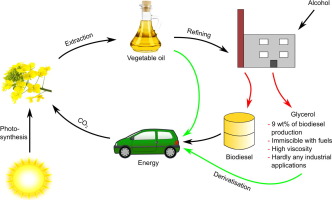Our official English website, www.x-mol.net, welcomes your
feedback! (Note: you will need to create a separate account there.)
Optimising the biodiesel production process: Implementation of glycerol derivatives into biofuel formulations and their potential to form hydrofuels
Fuel ( IF 6.7 ) Pub Date : 2020-03-01 , DOI: 10.1016/j.fuel.2019.116695 Damian Brock , Alexander Koder , Hans-Peter Rabl , Didier Touraud , Werner Kunz
Fuel ( IF 6.7 ) Pub Date : 2020-03-01 , DOI: 10.1016/j.fuel.2019.116695 Damian Brock , Alexander Koder , Hans-Peter Rabl , Didier Touraud , Werner Kunz

|
Abstract A new biofuel concept is developed, enabling the usage of vegetable oils and glycerol derivatives in mixtures with biodiesel. This concept significantly enhances the biodiesel production's profitability and thus strongly contributes to the sustainability of future biofuels. After simple addition reactions with building block chemicals, less hydrophilic glycerol derivatives are obtained, which are compatible with biofuels. Even more, the products of the reactions of glycerol with acetone or butyric acid, referred to as solketal and tributyrin, respectively, lead to promising biofuels in mixtures with rapeseed oil and its biodiesel. Due to their low freezing points, they act as cloud and freezing point depressants, when added to vegetable oil/biodiesel blends. Further, since their viscosity is close to common biodiesel, biofuels containing high amounts of vegetable oil and even more glycerol derivatives than they arise during the biodiesel production can be obtained. Thus, this new class of biofuels enables adaptable compositions depending on the application and also the usage as drop-in fuel without any or just few percent of further additives. After optimising the formulations, ignition delay, exhaust gas recirculation, fuel consumption and combustion process measurements were performed in an unmodified upto-date diesel engine. The experiments showed that the properties of the formulated biofuels are either similar to or even better than diesel. The hydrotropy of the glycerol derivatives in these mixtures enables the potential to implement water into biofuels, so-called hydrofuels, reducing nitrogen oxide emissions and leading to further optimised dropin fuels.
中文翻译:

优化生物柴油生产过程:甘油衍生物在生物燃料配方中的应用及其形成水燃料的潜力
摘要 开发了一种新的生物燃料概念,使植物油和甘油衍生物与生物柴油混合使用。这一概念显着提高了生物柴油生产的盈利能力,从而有力地促进了未来生物燃料的可持续性。在与结构单元化学品进行简单的加成反应后,获得亲水性较低的甘油衍生物,它们与生物燃料相容。更重要的是,甘油与丙酮或丁酸反应的产物,分别称为 solketal 和三丁酸甘油酯,在与菜籽油及其生物柴油的混合物中产生有前景的生物燃料。由于它们的冰点低,当添加到植物油/生物柴油混合物中时,它们可作为混浊剂和冰点抑制剂。此外,由于它们的粘度接近普通生物柴油,可以获得含有大量植物油和比生物柴油生产过程中产生的甘油衍生物更多的生物燃料。因此,这种新型生物燃料能够根据应用以及作为插入式燃料的用途来调整组合物,而无需任何或仅添加少量其他添加剂。优化配方后,点火延迟、废气再循环、燃料消耗和燃烧过程测量在未经修改的最新柴油发动机中进行。实验表明,配制的生物燃料的特性与柴油相似,甚至优于柴油。这些混合物中甘油衍生物的水溶性使得有可能将水转化为生物燃料,即所谓的水力燃料,从而减少氮氧化物排放并进一步优化燃料。
更新日期:2020-03-01
中文翻译:

优化生物柴油生产过程:甘油衍生物在生物燃料配方中的应用及其形成水燃料的潜力
摘要 开发了一种新的生物燃料概念,使植物油和甘油衍生物与生物柴油混合使用。这一概念显着提高了生物柴油生产的盈利能力,从而有力地促进了未来生物燃料的可持续性。在与结构单元化学品进行简单的加成反应后,获得亲水性较低的甘油衍生物,它们与生物燃料相容。更重要的是,甘油与丙酮或丁酸反应的产物,分别称为 solketal 和三丁酸甘油酯,在与菜籽油及其生物柴油的混合物中产生有前景的生物燃料。由于它们的冰点低,当添加到植物油/生物柴油混合物中时,它们可作为混浊剂和冰点抑制剂。此外,由于它们的粘度接近普通生物柴油,可以获得含有大量植物油和比生物柴油生产过程中产生的甘油衍生物更多的生物燃料。因此,这种新型生物燃料能够根据应用以及作为插入式燃料的用途来调整组合物,而无需任何或仅添加少量其他添加剂。优化配方后,点火延迟、废气再循环、燃料消耗和燃烧过程测量在未经修改的最新柴油发动机中进行。实验表明,配制的生物燃料的特性与柴油相似,甚至优于柴油。这些混合物中甘油衍生物的水溶性使得有可能将水转化为生物燃料,即所谓的水力燃料,从而减少氮氧化物排放并进一步优化燃料。





















































 京公网安备 11010802027423号
京公网安备 11010802027423号